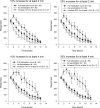Sensitization and habituation of motivated behavior in overweight and non-overweight children
- PMID: 19649135
- PMCID: PMC2597853
- DOI: 10.1016/j.lmot.2008.03.001
Sensitization and habituation of motivated behavior in overweight and non-overweight children
Abstract
The rate of habituation to food is inversely related to energy intake, and overweight children may habituate slower to food and consume more energy. This study compared patterns of sensitization, as defined by an initial increase in operant or motivated responding for food, and habituation, defined by gradual reduction in responding, for macaroni and cheese and pizza in overweight and non-overweight 8-12 year-old children. Non-overweight children habituated faster to both foods than overweight children (p = 0.03). All children recovered motivated responding for a new food (chocolate). Overweight children consumed more energy than non-overweight children (p = 0.0004). Children who showed a sensitization in responding consumed more food (p = 0.001), and sensitization moderated the effect of overweight on habituation, with slower habituation for overweight children who sensitized (p < 0.0001). This study replicates previous data on overweight/non-overweight differences in habituation of food and of energy intake, and provides new information that individual differences in sensitization and habituation of motivated responding to food cues may be associated with a sustained motivation to eat, resulting in greater energy intake.
Figures





Similar articles
-
Variety influences habituation of motivated behavior for food and energy intake in children.Am J Clin Nutr. 2009 Mar;89(3):746-54. doi: 10.3945/ajcn.2008.26911. Epub 2009 Jan 28. Am J Clin Nutr. 2009. PMID: 19176724 Free PMC article. Clinical Trial.
-
What constitutes food variety? Stimulus specificity of food.Appetite. 2010 Feb;54(1):23-9. doi: 10.1016/j.appet.2009.09.001. Epub 2009 Sep 16. Appetite. 2010. PMID: 19765625 Free PMC article.
-
Habituation and within-session changes in motivated responding for food in children.Appetite. 2008 Mar-May;50(2-3):390-6. doi: 10.1016/j.appet.2007.09.005. Epub 2007 Sep 21. Appetite. 2008. PMID: 17961817 Free PMC article.
-
Food reinforcement and habituation to food are processes related to initiation and cessation of eating.Physiol Behav. 2021 Oct 1;239:113512. doi: 10.1016/j.physbeh.2021.113512. Epub 2021 Jul 1. Physiol Behav. 2021. PMID: 34217735 Free PMC article. Review.
-
Habituation as a determinant of human food intake.Psychol Rev. 2009 Apr;116(2):384-407. doi: 10.1037/a0015074. Psychol Rev. 2009. PMID: 19348547 Free PMC article. Review.
Cited by
-
The Nature of Available Choices Affects the Intake and Meal Patterns of Rats Offered a Palatable Cafeteria-Style Diet.Nutrients. 2023 Dec 13;15(24):5093. doi: 10.3390/nu15245093. Nutrients. 2023. PMID: 38140351 Free PMC article.
-
ERP and oscillatory differences in overweight/obese and normal-weight adolescents in response to food stimuli.J Eat Disord. 2020 Apr 7;8:14. doi: 10.1186/s40337-020-00290-8. eCollection 2020. J Eat Disord. 2020. PMID: 32280464 Free PMC article.
-
Variety influences habituation of motivated behavior for food and energy intake in children.Am J Clin Nutr. 2009 Mar;89(3):746-54. doi: 10.3945/ajcn.2008.26911. Epub 2009 Jan 28. Am J Clin Nutr. 2009. PMID: 19176724 Free PMC article. Clinical Trial.
-
Rationale and consequences of reclassifying obesity as an addictive disorder: neurobiology, food environment and social policy perspectives.Physiol Behav. 2012 Aug 20;107(1):126-37. doi: 10.1016/j.physbeh.2012.05.005. Epub 2012 May 11. Physiol Behav. 2012. PMID: 22583861 Free PMC article. Review.
-
Habituation of reinforcer effectiveness.Front Integr Neurosci. 2014 Jan 9;7:107. doi: 10.3389/fnint.2013.00107. Front Integr Neurosci. 2014. PMID: 24409128 Free PMC article. Review.
References
-
- Duffy E. Activation. In: Greenfield NS, Sternbach RA, editors. Handbook of Psychophysiology. Holt, Rinehart and Winston, Inc.; New York: 1972. pp. 577–622.
-
- Epstein LH, Mitchell SL, Caggiula AR. The effect of subjective and physiological arousal on dishabituation of salivation. Physiology and Behavior. 1993;53:593–597. - PubMed
-
- Epstein LH, Paluch R, Coleman KJ. Differences in salivation to repeated food cues in obese and nonobese women. Psychosomatic Medicine. 1996;58:160–164. - PubMed
-
- Epstein LH, Paluch RA. Habituation of facial muscle responses to repeated food stimuli. Appetite. 1997;29:213–224. - PubMed
-
- Epstein LH, Rodefer JS, Wisniewski L, Caggiula AR. Habituation and dishabituation of human salivary response. Physiology and Behavior. 1992;51:945–950. - PubMed
Grants and funding
LinkOut - more resources
Full Text Sources
Medical
